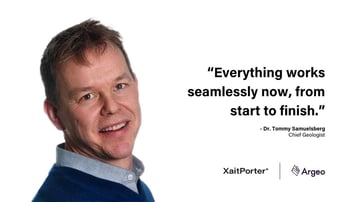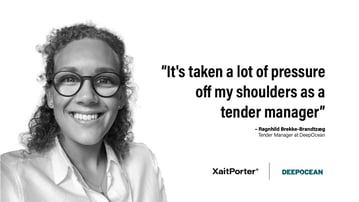Without a win strategy, your team may waste considerable time writing, blindly searching for how to convey your value to the customer. And your customer will waste significant time searching your document for a reason to buy.
In this blog, we will explore the essential components of a winning strategy, including actionable tips and insights, to help you and your team secure new business and drive growth.
What is a Proposal Win Strategy?
An effective win strategy is a natural extension of the capture strategy.
- The capture strategy defines how your business will win a specific contact, project, or opportunity, For example this includes research into and analysis of key decision makers and competitors.
- The win strategy defines how your team will write the response. For example, this includes value proposition and win themes,
By outlining how to effectively articulate your capture strategy through story, persuasive writing techniques and evidence, a well-crafted win strategy provides your team with a clear roadmap for writing and resonating with readers.
Features and Benefits
The win strategy significantly enhances your chances of writing winning competitive bids:
- Improved Readability. Ensures a clear, logical and easy-to-follow flow of information, sentence structure, and formatting. This makes it easier for readers to navigate your document and find what they are looking for.
- Improved Understanding. Ensures readers comprehend the often complex concepts and messages you are trying to communicate. This builds reader trust and a craving to know more.
- Improved Proof. Ensures readers believe your arguments and claims. This builds credibility in your approach and experience.
- Enhanced Efficiency. Ensures contributors use their time wisely, invested in quality content. This focuses writing tasks and saves time for more bids.
By investing in a robust win strategy, you can unlock a range of benefits that will help your business achieve greater, more impactful results.
Win strategy in proposal development
A well-crafted win strategy is the cornerstone of effective bid writing. By understanding your customer, your value proposition and how to communicate with readers, your team can deliver a high-quality document that significantly increases your chances of success.
Understand the Capture Strategy
Over months, if not years, your sales, business development, and/or capture team has been diligently working to cultivate relationships, gather intelligence on client projects, and analyze competitive landscapes.
By understanding and interpreting your capture strategy, you can leverage your team's efforts to create a competitive bid that truly resonates with the client and positions your organization as the ideal partner.
- Understand the Client: The client's organization, industry, and project as well as needs, goals, fears, and doubts.
- Understand Key Decision-makers: The decision-makers and influencers, their needs, goals and priorities and what motivates them.
- Understand the Competitive Landscape: Who else might be bidding, especially if an incumbent is in place, their strengths and weaknesses.
- Understand your Unique Selling Points (USPs): What makes your solution different and better.
- Understand the Benefits: What data and metrics will demonstrate the value your solution provides.
Analyze the RFP or Tender
As you develop your win strategy, it's essential to thoroughly analyze and understand the Request for Proposal (RFP) or Invitation to Tender (ITT). By investing this time now, you'll better focus your team on specific tasks and avoid major revisions med-development.
- Scope: The project's objectives, deliverables, staffing, milestones, and timelines.
- Key Requirements: Pinpoint the specific criteria you must meet at a minimum to comply.
- Evaluation Criteria: How your offer will be judged and scored.
- Clarify anything ambiguities: Seek clarification with the issuing authority on any unclear or confusing points. Be cautions; you don’t want to reveal any weaknesses to the customer or competition.
Key Components
Remember, a winning offer is more than just a well-written document. It is a carefully crafted strategy designed to capture the reader’s attention and persuade them you are the right partner for the project.
To develop a successful win strategy, it’s essential to understand key components of proposal management:
- Value Proposition: Clearly articulates the benefits your solution offers and differentiates you from the competition. It is as long or short as necessary, but must be concise and clear and focused on the core benefits. A good rule of thumb is to aim for a value proposition that can be easily remembered and communicated.
- Win Theme: A central idea or concept that unites your bid and makes it memorable. Perhaps it’s a slogan, or a tagline, or even a visual metaphor that captures the essence of your solution and its benefits. For example, “empowering innovation” or “driving efficiency” or “a sustainable future.”
- Differentiators: Unique selling points that set you apart from the competition. Basically, the reasons why a customer should choose you over the others. For example, “integration” or “scalability.”
- Discriminators: Are also unique selling points that set your offering apart from the competition, with one essential difference. Discriminators are also acknowledged by the customer as important. They corroborate your claims and give the customer reasons to believe you are better than your competition - without speaking negatively about your competitors.
- Proof Points: The data, examples, or customer success stories or quotes you will use to prove your claims. For example, client quotes or case studies, industry analysis or user reviews.
- A Compelling Story: Identify the main characters, for example, the customer, decision makers and influencers. Define their journey from conflict, or problem and challenge to overcoming and achieving their goals. A storyboard, or visual planning tool is useful here to define and communicate the story to contributors.
Suggested content



Annotate the Outline
Once you have outlined your document according to the RFP or Tender requirements, annotating it is the critical next step in translating your win strategy into action. By carefully organizing your thoughts and providing context now, you can ensure your document is logical, customer-focused, and effectively communicates your value proposition.
Beginning with key sections, based on the evaluation criteria, provide guidance to your expert contributors that helps them deliver the content you are looking for without major revisions. For example:
- Target Reader and Tone: Identify the primary and secondary reader and the tone, for example formal, information, persuasive or informative.
- Key Messages: Indicate which ideas or arguments are most crucial to convey, and what about your value proposition should be emphasized.
- Evaluation Criteria: Indicate which areas will be heavily weighted in the evaluation process.
- Address Concerns: Identify what concerns the reader might have at this point and how to counter their fears.
- Evidence: Suggest what proof points would support arguments and claims.
- Opening Hook: Suggest a compelling anecdote, statistic, fact, or question that grabs the reader's attention and reminds them of the problem they are trying to solve.
- Strong Closing: Remind contributors to reinforce your value proposition by summarizing the benefits of your solution.
- Visuals: Indicate where diagrams, charts, or images would be beneficial to support the content.
Get your Team On Board with Win Strategy
In addition to annotating your outline to guide contributors, take steps to ensure they understand, and are on board with your value proposition and win theme.
- Communicate the Importance: Clearly explain how the win strategy will benefit the customer.
- Provide Training: Offer workshops on the win strategy and how it relates to specific sections.
- Encourage Feedback: Create an open environment where contributors can share their thoughts and suggestions for improving, and articulating, your win strategy.
Write Compelling Content
Remember, a winning pitch is more than just a document; it is an educational and persuasive tool for communicating your value proposition. By effectively leveraging your win strategy, you can create a compelling document that resonates with your customer and drives results.
- Tailor Reusable Content: Reusable content is a real time-saver, however, it must be tailored, or personalized, to resonate with your target customer. Focus on separating the facts from the context, and changing the context to speak to this specific customer.
- Empathize with the Reader: By understanding the reader’s perspective and addressing their specific needs and concerns, you create a more compelling and persuasive document.
- Highlight your Strengths: An impactful bid effectively showcases your unique strengths and capabilities.
- Ghost the Competition: Used with caution, this tactic is effective, especially when competition is high. Basically, you highlight a competitor's weakness, without naming them, by highlighting your strength. However, you must first understand what they will offer and the strengths and weaknesses of those offerings.
- Support Claims: Back up your statements with data, examples, and proof points.
Review and Revise
The first draft is written and it’s right on target. Now is your team’s opportunity to strengthen your document through iterative, independent reviews. By simulating the customer's evaluation process, scoring and identifying errors and weaknesses, your team can boost quality and overall impact.
- Review Team: Involve different perspectives for comprehensive results. For example, including reviewers who do not know the customer or the offering provides better feedback or readability.
- Review Feedback: Be clear about what you’re looking for. You want ideas for how to improve so you can boost your score. Not opinions on what has been written.
- Revision Roadmap: An effective review produces a revision “roadmap” highlighting specifically what to update to improve quality.
Managing the Process
Collaborative writing is essential for creating high-quality, persuasive documents. In some ways, it’s like a team sport. It requires the combined efforts of individuals with diverse skills and expertise. Just as a successful sports team relies on each player’s strengths, a winning bid team depends on the contributions of various team members.
Combined with a well-written win strategy, real-time collaboration helps your team win in two important ways. One, by breaking down work silos that require email to communicate. And two, by eliminating the emails that leave some contributors out of the conversation. Instead of miscommunication and delays, your team invests their time in:
- Improving Quality: By eliminating errors early on in the process, and ensuring a consistent tone, style, and message for a more compelling story.
- Enhancing Readability: By maintaining a logical and easy-to-follow structure and narrative that helps readers quickly grasp and accept your concepts and claims.
- Higher Evaluation Score: By consistently emphasizing your value proposition and win theme throughout your offer, articulated for target readers.
A win strategy is an invaluable tool for improving quality, driving efficiency, and ultimately boosting win rates. By implementing the strategies outlined in this blog, you can streamline your process, reduce rework, and create offerings that truly stand out from the competition.
Want to win the next contract? Remember, even the greatest experts need a roadmap. A win strategy and annotated outline provide valuable guidance, ensuring their time, expertise and insights are effectively channeled into your new business goals.









